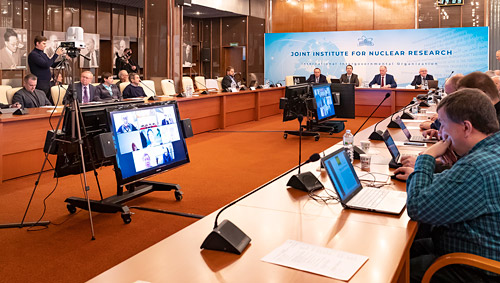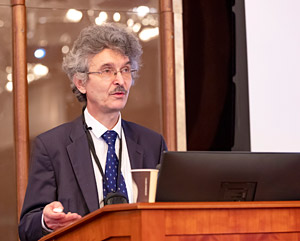
Electronic english version since 2022 |
The newspaper was founded in November 1957
| |
At PAC meetings
The Seven-Year Plan, the NICA complex and other projects
On 23 January, the 57th meeting of the Programme Advisory Committee for Particle Physics of JINR was held at the JINR International Conference Centre.

Due to the difficulties of air travel for members of the PAC, the meeting was held in the format of a videoconference with a shortened agenda. A small number of reports also concerns the discussion of the Seven-Year Plan - currently, the main areas are determined and specific research topics will be presented at the next meetings.
The Chairman of the Committee Professor Itzhak Tserruya opened the meeting and reported on the implementation of the recommendations of the previous PAC meeting.
The members of the PAC noted the significance of the Statement of the Committee of Plenipotentiaries of JINR on preserving the unity of the Institute, its scientific mission and international partnership in peace, adopted at the extraordinary meeting of the PAC on 21 March, 2022. The activities of the JINR Directorate that emphasize the international status of the Institute to overcome current challenges have been completely supported.
 A report on the Resolution of the 132nd session of the JINR Scientific Council (September 2022) and on the decisions of the Committee of Plenipotentiaries of the Governments of the JINR Member States in 2022 was made by JINR Vice-Director Vladimir Kekelidze. His second report was dedicated to the Seven-Year Plan for the Development of JINR for the period 2024-2030.
A report on the Resolution of the 132nd session of the JINR Scientific Council (September 2022) and on the decisions of the Committee of Plenipotentiaries of the Governments of the JINR Member States in 2022 was made by JINR Vice-Director Vladimir Kekelidze. His second report was dedicated to the Seven-Year Plan for the Development of JINR for the period 2024-2030.
The participants of the meeting approved the detailed presentation of the draft of the new Seven-Year Plan and strongly supported the identified priorities in the field of elementary particle physics and relativistic heavy-ion physics. Namely, the implementation of the physics programme for the investigation of baryonic matter and phase transitions at the BM@N and MPD experimental facilities after putting the NICA complex into operation; development of the first stage of the SPD experimental facility for research in the field of spin physics; launch and support of the international user programme for interdisciplinary applied research based on NICA, development of the ARIADNA user infrastructure; development of international cooperation on major JINR projects: BM@N, MPD, SPD, Baikal-GVD.
A recommendation was reiterated to involve VBLHEP staff members in the timely completion of constructing the NICA complex, as well as external staff to strengthen interlaboratory cooperation at the NICA complex and internal experiments.
 Further, reports on the current work at the NICA accelerator complex were presented. For journalists, Anatoly Sidorin commented on recent achievements:
Further, reports on the current work at the NICA accelerator complex were presented. For journalists, Anatoly Sidorin commented on recent achievements:
"Today, we carry out startup and adjustment work at the accelerator complex of the Laboratory of High Energy Physics. Currently, this complex includes a source of specialized heavy ions, a heavy-ion linear accelerator, two cyclic superconducting accelerators and a significantly modernized beamline for the transport of beams. The objectives of the meeting are to ensure the joint operation of all facilities and the stable operation of the complex for a long time when implementing physics experiments. In the first part, we worked for about 24 days for the SRC (Short-Range Correlation, correlation at short distances) experiment that was implemented by a large international collaboration. We currently work for the BM@N collaboration. Carbon ions were used for SRC and today - heavy xenon ions.
It is worth noting the problems that had to be met at the accelerator. First, the complex operated on heavy ions even under the old injection chain, when the injection from the linear accelerator was carried out directly into the Nuclotron. The beam intensity was 105 ions per acceleration cycle. Today, thanks to the modernization of the complex and the inclusion of new units, we have increased the intensity a hundredfold. Of course, not everything turned out as well as it had been intended. Startup and adjustment work ensured the intensity sufficient for the operation of all diagnostic systems and further construction of the accelerator complex. And today, for more than a month, statistics have been accumulated for the BM@N experiment."
In the report "Implementation of the Nuclotron-NICA project", Anatoly Sidorin presented the results of the third, record-breaking, startup session that was held from 2 January to 1 April, 2022. The fourth session started on 20 September, 2022 and lasts to this day, depending on how fast the participants of the BM@N collaboration accumulate statistics (500 million events are scheduled).
The Committee highly appreciated the intensive work of the VBLHEP accelerator complex under the experimental programme at the SRC and BM@N facilities and congratulated the NICA team on the successful startup and joint operation of several units of the accelerator - the ion source, heavy ion linear accelerator, booster, Nuclotron and the modernized 136-meter beam transport line in the experimental building, as well as positioning all dipole superconducting magnets in the arches of the collider tunnel.
 VBLHEP Chief Engineer Nikolay Agapov presented the report on "Development of infrastructure, including the Nuclotron". It was noted that transformers were replaced at the main transformer substation "Dubna" that allowed to increase the capacity to 40.8 MW. It completely meets the needs of the NICA megaproject. The final startup and adjustment work is scheduled at the end of the current accelerator session. Russia's largest helium liquefier with a capacity of 1000 liters per hour and a cooler for a booster with a capacity of 2000 W were put into operation at the cryogenic complex. The construction of the collider building is at the final stage that will allow the installation of the collider equipment, the MPD detector and the electronic cooling system.
VBLHEP Chief Engineer Nikolay Agapov presented the report on "Development of infrastructure, including the Nuclotron". It was noted that transformers were replaced at the main transformer substation "Dubna" that allowed to increase the capacity to 40.8 MW. It completely meets the needs of the NICA megaproject. The final startup and adjustment work is scheduled at the end of the current accelerator session. Russia's largest helium liquefier with a capacity of 1000 liters per hour and a cooler for a booster with a capacity of 2000 W were put into operation at the cryogenic complex. The construction of the collider building is at the final stage that will allow the installation of the collider equipment, the MPD detector and the electronic cooling system.
Acting leader of the MPD Collaboration Victor Ryabov (PNPI) spoke about the progress of the project. Production of all components for the first stage of the MPD detector configuration is in a good progress. The startup of the time-projection chamber and the time-of-flight subsystem with readout electronics is in process, the assembly should be completed in 2023. 1600 modules of the electromagnetic calorimeter have been manufactured in Russia and China. Trial assembly of the first half-sectors has started, it is scheduled that by November 2023, 16 of the 25 sectors of the ECAL detector will be ready. Attempts are made to manufacture 400 extra modules in Russia to be installed in the detector prior to its operation. The most important tasks in the first half of 2023 will be cooling, powering and testing the large MPD superconducting solenoid followed by magnetic field measurements. The PAC experts congratulated the MPD collaboration for finding viable solutions to the critical problems encountered in the manufacture, assembly and startup of detector units.
The PAC highly appreciates the progress in the implementation of the BM@N project, the report on which was presented by Head of Department of VBLHEP Mikhail Kapishin. An important stage of the project is the physics experiment with a xenon beam interacting with a CsI target that started in November and will last until the end of January. The data accumulation system has already registered over 300 million Xe+CsI interactions. The experiment is carried out with a complete set of detectors. The members of the PAC noted the successful operation of the vacuum beamline that has significantly reduced the beam background in the BM@N detectors. Mikhail Kapishin also noted that today, the international collaboration of the experiment includes 184 participants from 10 institutes in three countries.
The leader of the SPD Collaboration Alexey Guskov presented a report on the technical draft of the detector. The Committee acknowledged the progress made by the Collaboration in preparing the technical draft based on the results obtained during the development and testing of SPD prototype subsystems. The classical solenoid magnet system has been selected. The SPD project is expected to be implemented in two stages. The basic configuration will be used for measurements with polarized proton and deuteron beams at low collision energies and luminosities below nominal. At the second stage, a complete configuration will be developed that is necessary for the implementation of the main task of SPD - the investigation of the polarized gluon structure of nucleons.
It is recommended to update the project taking into account the current availability of materials and equipment, their cost, as well as to establish an expert committee for a thorough research of the technical draft.
In accordance with the request made at the 55th meeting, the PAC listened to the progress reports of the two JINR groups participating in the T2K-II and COMET projects.
Head of the Department of DLNP Yury Davydov made a report on the course of JINR's participation in the T2K-II project. Over the past 1,5 years, the JINR group has contributed to the modernization of the ND280 near-field detector of the T2K experiment, participated in the assembly of the detector at J-PARC and in the development of the SFGD calibration system. All this work was highly appreciated by the PAC and JINR's further participation in the second stage of the T2K-II experiment was recommended until the end of 2024 with the B rating.
A report on JINR's participation in the COMET project at J-PARC was presented by Head of the Sector of DLNP Zviad Tsamalaidze. In 2022, JINR physicists made a significant contribution to the development and manufacture of several detector subsystems for the initial stage of the COMET experiment. The participants of the PAC meeting acknowledged the leading role of the JINR group in the development and manufacture of the main subsystems of the COMET detector, noted with satisfaction the participation of JINR staff members in the administration structures of the COMET Collaboration, and recommended the further implementation of the project until the end of 2024 with the A rating.
Next, reports were presented on the scientific results obtained by JINR groups in the experiments at LHC: ALICE, ATLAS, CMS. The members of the PAC highlighted the increasing scientific significance and wider participation in the physical analysis of the three JINR groups in these experiments.
The posters presented by young scientists from VBLHEP, MLIT and DLNP were reviewed at the Zoom meeting of the PAC. In general, the reports were estimated highly. The Committee chose the paper "Investigation of the correlation between the kinetic energy of a track and its energy response in ZDC for the 7th session of the BM@N experiment" prepared by Ksenia Alishina for presentation at the next session of the Scientific Council in February 2023.
The next meeting of the PAC for Particle Physics is scheduled for 21-22 June, 2023.
Galina MYALKOVSKAYA,
photo by Elena PUZYNINA